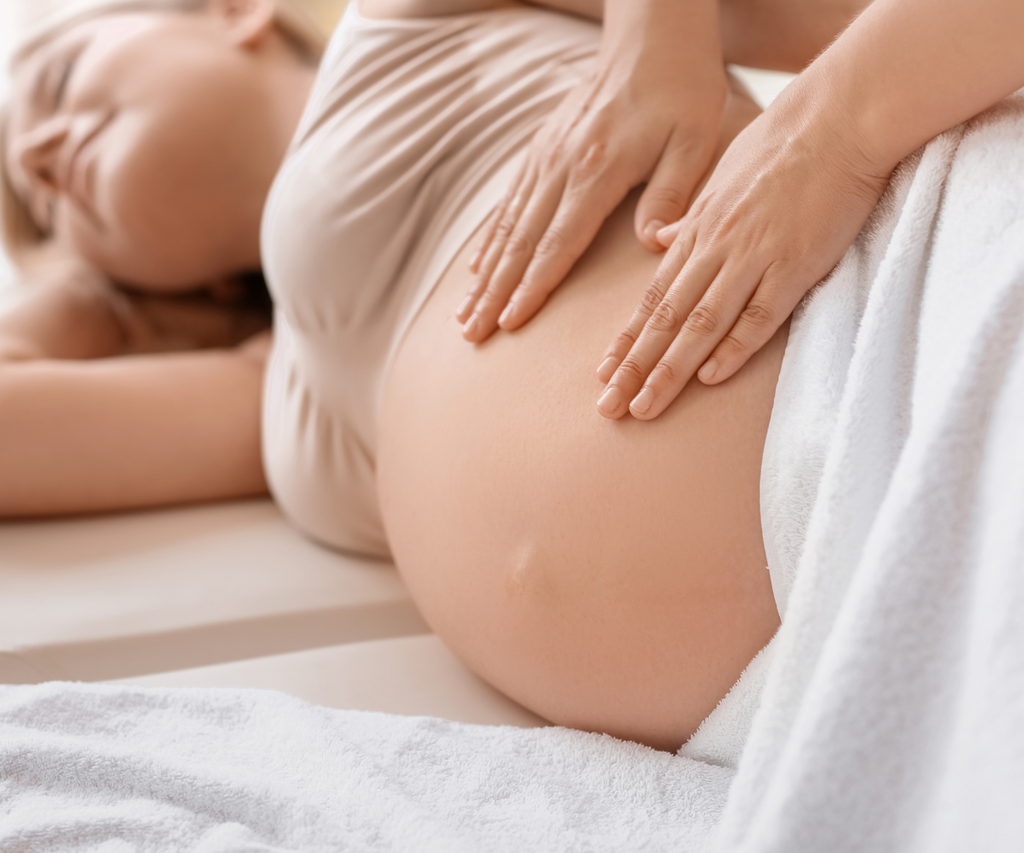
Pregnancy can put a lot of strain on our bodies. Joint and back pain, swelling, and increased hormones and blood flow are just some of the things that may ail you as your body is growing and supporting your baby. A prenatal massage is a great solution that can help you find relief and improve your mood. Read on to learn more about prenatal massage, its benefits, and how to add it to your prenatal care routine.
What Is a Prenatal Massage?
A prenatal massage is a special type of massage done during pregnancy that is designed to benefit and be safe for you and your baby. A pregnancy massage is similar to a regular massage, but differs in terms of pressure points, areas of focus, and positioning.
The main goals are to ease sore and achy muscles and improve your circulation and mobility. When you are ready to begin massage therapy, seek out a massage therapist who is specifically trained in prenatal massage.

When to Get a Prenatal Massage
It is best to wait until the second trimester to begin massage therapy. Many massage therapists won’t see pregnant women until after the first trimester due to the higher risk of miscarriage during this time. When completed by a trained prenatal massage therapist, a pregnancy massage is safe for you and your baby from the second trimester through the rest of your pregnancy.
Always check in with your healthcare provider before scheduling any spa treatments. If your pregnancy is high-risk, they may have further precautions or recommendations for you to follow.
Benefits to Getting a Prenatal Massage
Prenatal massage is a beneficial addition to your prenatal care routine, leading to you feeling both physically and mentally better throughout your pregnancy.
The benefits of prenatal massage extend past expectant mothers to their babies. According to the American Pregnancy Association, regular massage therapy can lead to a healthy birth weight and fewer birth and newborn complications.
There are many other benefits of prenatal massage, including:
Reduced Swelling
Swelling, also called edema, can occur in joints, ankles, hands, and feet. This is commonly caused by the increased weight and pressure on blood vessels by the uterus, reduced circulation, and increased fluid retention. Prenatal massage techniques target soft tissues, improving circulation to reduce excess fluid retention at the joints and increase waste removal by the lymphatic system.
Connection with New Baby
By decreasing your stress levels through massage therapy, you can improve your pregnancy experience and allow yourself to feel a deeper connection with your growing baby.
Stabilize Hormones
Regular massage therapy has been shown to decrease stress hormones like cortisol and increase hormones like serotonin, leading to better mood regulation. Low serotonin and dopamine have been linked to depression and anxiety, and high stress hormones can lead to high blood pressure and negatively affect cardiovascular health.
Improved Sleep and Mood
Another benefit tied in with massage and hormone stabilization is improved sleep. When serotonin levels increase, it helps lessen pain. It is also essential to the development of melatonin, the sleep hormone. So with less pain and natural melatonin, you will be on your way to better sleep and a more stable mood!
Back Pain Relief
Pregnancy puts a lot of pressure on your body, especially your lower back. As your pregnancy progresses, ligaments begin to stretch and relax, especially in the third trimester. This stretching and relaxing can actually lead to pain and discomfort due to excess strain being put on supporting ligaments. Massage can help improve posture and ease sore muscles, leading to less pain and discomfort as a result.
Another common type of lower back pain comes from the sciatic nerve. Sciatica occurs when your growing uterus puts pressure on your pelvic floor and lower back, which then swells and presses on this nerve. Prenatal massage decreases tension on these muscles, allowing swelling to reduce, and pressure to be released.

Reduced Labor Complications
Regular prenatal massage therapy has been shown to lower the risks of low birth weight and preterm birth.
Things to Avoid:
-
Contrast hydrotherapy. This means altering hot and cold temperatures. It is better to maintain a constant mild temperature.
-
Hot baths, steam rooms, and saunas. Overheating can be dangerous to you and your baby. Heat and sweating causes decreased blood flow, which means less oxygen for your baby.
-
Body wraps. These cause an increase in body temperature and cause you to sweat, decreasing blood flow and oxygen to your uterus.
-
Detoxifying body scrubs. These may release toxins into your bloodstream, which may make it past the blood-placenta barrier.
Differences Between Prenatal Massages and Regular Massages
When receiving a prenatal massage, the massage therapist will provide expectant mothers with a modified massage table or pillow and bolster set up to accommodate their growing belly and likely sore breasts as they lie on their back. After 20 weeks of pregnancy, it is not safe to lie on your back for extended periods of time, so for the entirety of the massage, you will likely be facedown or side-lying.
The massage techniques used for expectant mothers are most similar to those used for Swedish massage. A Swedish massage is not a deep-tissue massage. This type of massage uses mild pressure in order to relax muscle tension and improve lymphatic and blood circulation. The massage techniques used will help ease discomfort from skeletal and circulatory changes caused by pregnancy’s hormone shifts.
How to Do a Prenatal Massage at Home
You may not find a prenatal massage therapist in your area, or maybe you are saving your money for that perfect nursery glider. You can still experience the benefits of a prenatal massage from home. With the help of your partner, a family member, or a friend, you can follow these steps for a relaxing pregnancy massage at home.
-
Ask for help. Anyone who has tried to give themselves a foot rub knows it is not as relaxing as when someone else does it for you. And as your belly grows, it may even become impossible! So to get the relaxing relief you need, enlist the help of your partner, a family member, or friend.
-
Gentle foot massage. Using gentle pressure, have your helper rub the top of your foot, working their way from the toes up to the tops of your feet in small circles. Using both thumbs, they can then rub the bottom of your feet from the toes, to the sole and the heel. A light tug on each toe may also help. Avoid any pressure or manipulation to the ankles, due to the pressure points around here that are thought to promote labor.
-
Back rub. A seated or side-lying position is a good choice for an at-home back massage. Your helper can focus on specific areas of pain such as your upper or lower back. Have your helper focus on the muscles on either side of the spine and use their fingertips or knuckles to gently knead up and down.
-
Shoulder rub. Using gentle pressure, have your helper slide their palms or fingertips down the side of your neck, over the tops of your shoulders, and back to the base of your skull.
-
Scalp massage. With both hands, have your helper spread their fingers and then massage light circles from the base of your skull through your hairline.
-
A belly massage is not recommended. Instead, lightly rub your belly with lotion for a soothing effect that can help prevent stretch marks.
Another great option for pain relief and relaxation is prenatal yoga. The breathwork and light stretching can give you many of the same benefits as a massage. You can find a studio, or practice at home!

Q&A
How Much Do Prenatal Massages Cost?
An hour-long prenatal massage may cost anywhere from $60 to $150.
Can Pregnant Women Get Massages?
Yes! Wait to begin massage therapy until the second trimester, and always ask your healthcare provider before any spa treatments, especially if you have a high risk pregnancy or conditions like preeclampsia.
How Do I Find a Prenatal Massage Expert?
When booking your first pregnancy massage, find a therapist who is certified in prenatal massage. These massage therapists have gone through continuing education or advanced training courses specifically for pregnancy massage.
How Often Should I Get Prenatal Massages?
During the second trimester, it is best to have prenatal massages once per month. Once you reach the third trimester, you can have prenatal massages every two weeks, and then weekly after week 36 to help prepare you for labor. However, you and your massage therapist can come up with an individualized plan that best suits your needs.
Regularly scheduled prenatal massages, whether by a certified prenatal massage therapist or an at-home pregnancy massage by your partner, can greatly benefit your mood and health during your pregnancy.
For more information on all things pregnancy and beyond, check out our posts on Nurture&’s journal. We also invite you to visit Nurture&’s website for all of your nursery essentials.








